Taenia infection: Difference between revisions
| Line 54: | Line 54: | ||
'''D''', '''E''', '''F''', '''G''': Gravid proglottids of Taenia saginata (Figures '''D''' and '''E''') and Taenia solium (Figures '''F''' and '''G'''). Injection of India ink in the uterus allows visualization of the primary lateral branches. Their number allows differentiation between the two species: T. saginata has 15 to 20 branches on each side (Figure '''D''' and '''E'''), while Taenia solium has 7 to 13 (Figures '''F''' and '''G'''). Note the genital pores in mid-lateral position. | '''D''', '''E''', '''F''', '''G''': Gravid proglottids of Taenia saginata (Figures '''D''' and '''E''') and Taenia solium (Figures '''F''' and '''G'''). Injection of India ink in the uterus allows visualization of the primary lateral branches. Their number allows differentiation between the two species: T. saginata has 15 to 20 branches on each side (Figure '''D''' and '''E'''), while Taenia solium has 7 to 13 (Figures '''F''' and '''G'''). Note the genital pores in mid-lateral position. | ||
== Treatment == | == Treatment == | ||
Revision as of 21:47, 7 February 2012
| Taenia infection | |
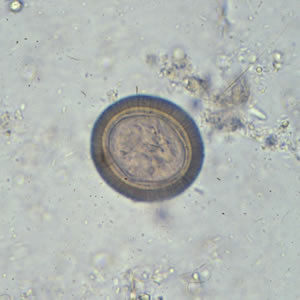 | |
|---|---|
| Taenia egg |
|
Taenia infection Microchapters |
|
Diagnosis |
|---|
|
Treatment |
|
Case Studies |
|
Taenia infection On the Web |
|
American Roentgen Ray Society Images of Taenia infection |
Editor-In-Chief: C. Michael Gibson, M.S., M.D. [1]
Overview
Epidemiology and Demographics
Both species are worldwide in distribution. Taenia solium is more prevalent in poorer communities where humans live in close contact with pigs and eat undercooked pork, and is very rare in Muslim countries.
Pathophysiology & Etiology
The cestodes (tapeworms) Taenia saginata (beef tapeworm) and T. solium (pork tapeworm). Taenia solium can also cause cysticercosis.
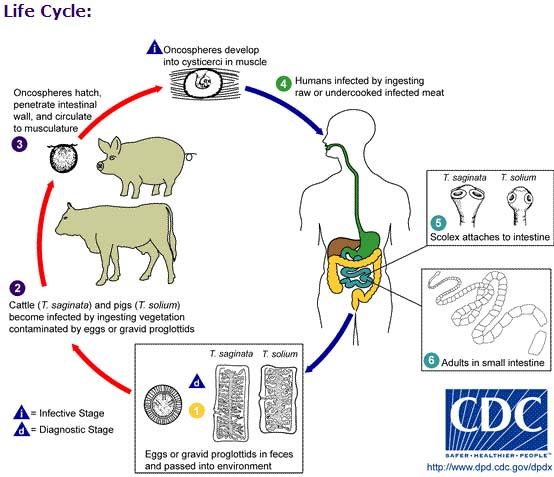
Taeniasis is the infection of humans with the adult tapeworm of Taenia saginata or Taenia solium. Humans are the only definitive hosts for T. saginata and T. solium. Eggs or gravid proglottids are passed with feces 1 ; the eggs can survive for days to months in the environment. Cattle (T. saginata) and pigs (T. solium) become infected by ingesting vegetation contaminated with eggs or gravid proglottids 2 . In the animal's intestine, the oncospheres hatch 3 , invade the intestinal wall, and migrate to the striated muscles, where they develop into cysticerci. A cysticercus can survive for several years in the animal. Humans become infected by ingesting raw or undercooked infected meat 4 . In the human intestine, the cysticercus develops over 2 months into an adult tapeworm, which can survive for years. The adult tapeworms attach to the small intestine by their scolex 5 and reside in the small intestine 6 . Length of adult worms is usually 5 m or less for T. saginata (however it may reach up to 25 m) and 2 to 7 m for T. solium. The adults produce proglottids which mature, become gravid, detach from the tapeworm, and migrate to the anus or are passed in the stool (approximately 6 per day). T. saginata adults usually have 1,000 to 2,000 proglottids, while T. solium adults have an average of 1,000 proglottids. The eggs contained in the gravid proglottids are released after the proglottids are passed with the feces. T. saginata may produce up to 100,000 and T. solium may produce 50,000 eggs per proglottid respectively.
History and Symptoms
Taenia saginata taeniasis produces only mild abdominal symptoms. The most striking feature consists of the passage (active and passive) of proglottids. Occasionally, appendicitis or cholangitis can result from migrating proglottids. Taenia solium taeniasis is less frequently symptomatic than Taenia saginata taeniasis. The main symptom is often the passage (passive) of proglottids. The most important feature of Taenia solium taeniasis is the risk of development of cysticercosis.
References
http://www.dpd.cdc.gov/dpdx/HTML/Taeniasis.htm
Laboratory Findings
Microscopic identification of eggs and proglottids in feces is diagnostic for taeniasis, but is not possible during the first 3 months following infection, prior to development of adult tapeworms. Repeated examination and concentration techniques will increase the likelihood of detecting light infections. Nevertheless, speciation of Taenia is impossible if solely based on microscopic examination of eggs, because all Taenia species produce eggs that are morphologically identical. Eggs of Taenia sp. are also indistinguishable from those produced by cestodes of the genus Echinococcus (tapeworms of dogs and other canid hosts). Microscopic identification of gravid proglottids (or, more rarely, examination of the scolex) allows species determination.

A, B: Taeniid eggs. The eggs of Taenia saginata and Taenia solium are indistinguishable morphologically (morphologic species identification will have to rely on the proglottids or scolices). The eggs are rounded, diameter 31 to 43 µm, with a thick radially striated brown shell. Inside each shell is an embryonated oncosphere with 6 hooks. The egg in Figure B still has the primary membrane that surrounds eggs in the proglottids.
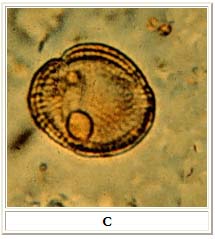
C: Pollen artifact that could be mistaken for a taeniid egg; however, the shell is thinner, of nonuniform thickness, and no hooks are visible.
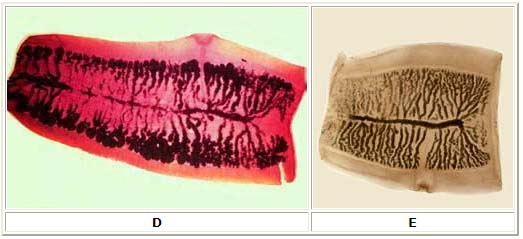
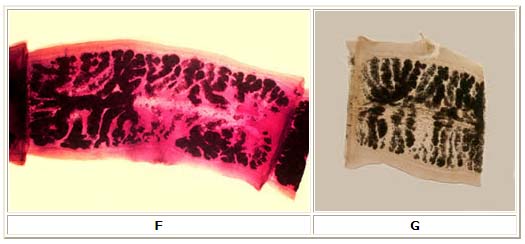
D, E, F, G: Gravid proglottids of Taenia saginata (Figures D and E) and Taenia solium (Figures F and G). Injection of India ink in the uterus allows visualization of the primary lateral branches. Their number allows differentiation between the two species: T. saginata has 15 to 20 branches on each side (Figure D and E), while Taenia solium has 7 to 13 (Figures F and G). Note the genital pores in mid-lateral position.
Treatment
Pharmacotherapy
Treatment is simple and very effective. Praziquantel is the drug of choice (This drug is approved by the FDA, but considered investigational for this purpose).
References
http://www.dpd.cdc.gov/dpdx/HTML/Taeniasis.htm
Acknowledgements
The content on this page was first contributed by: C. Michael Gibson, M.S., M.D.